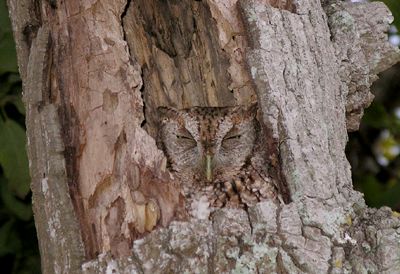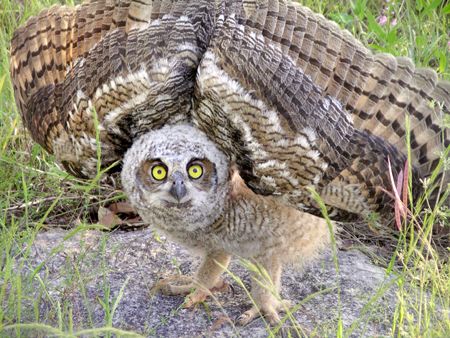
A Screech Owl in its retreat above our campground in Miami, FL, Feb. 2005
The number of different kinds of birds we can see on any ordinary day is enough to spark an interest in them. Vultures fly overhead, mockingbirds forage while we mow the grass, warblers dart about trees looking for insects, and waterfowl float on ponds. Many birds, with all manner of different habits, present themselves in full view of our binoculars when there is plenty of light by which to see them.
What about those birds that have the opposite preference? Some birds occasionally sing throughout the night, like the white-winged doves during the spring here in Texas, and others might migrate at that time, but, really, the vast majority of avian species are active during the day. One exception is the nightjar family, Caprimulgidae. Like bats, nighthawks and whip-poor-wills hunt insects on the wing in the dark. These birds spend their days hidden by their camouflage and are not high on the list of favorites for the casual birder. The premier nocturnal bird, though, is the owl. Even though nighthawks have the word "night" in their name, we often redundantly call people who like to stay up late "night owls," maybe because owls are just more familiar to more people.
 A Screech Owl in its retreat above our campground in Miami, FL, Feb. 2005 |
I've had relatively few encounters with owls, but, as they are so fascinatingly difficult to observe, those moments are often easy to recall. Over the past few decades, my preferred time to go for an exercise walk with the dog has been at dawn. Sometimes I go so early it is only barely beginning to get light, and that is the most likely time to catch a glimpse of an owl. With flight feathers so soft-edged that they hardly make any noise, it is quite a surprise when a huge bird suddenly appears with no warning. At times, they have swooped so close that I (and the dog) reflexively duck out of the way.
One of my more unusual owl encounters was a long time ago, when the Sunset Valley Shopping Center was new. Sunset Valley is a small community within Austin city limits that used to have, before housing developments proliferated, farms and mostly open fields and woods. When the shopping mall was created, a large chunk of land was paved over for the parking lots. The edging landscape was planted with native shrubs and grasses and some big boulders were decoratively placed in the gardens. I liked to walk around the edge of the lots, which gave the dog plenty of sniffing opportunities while I could stay on the pavement. As I was strolling along, a small bird flew past me from behind and landed on a large rock about 15 feet ahead. The fact that it soared so low to the ground that it had to fly UP to the rock was certainly unexpected. The dog and I were both startled and we stopped short at this odd intrusion. It was light enough that I got a good look at the little bird, which stood defiantly and stared right back. It was a burrowing owl. Those long legs and chunky body looked like something straight out of one of the nature documentaries that I was so fond of watching on television. We eyed each other for a short time, then I steered the dog in a wide circle around the perched bird, which just stood and watched us. One of the funniest things was that my canine companion made no attempt to pull towards or attack the interloper. I think she was totally nonplussed at the boldness of that diminutive owl and simply didn't know what to make of it.
Owls have some amazing anatomical features. Examining dead owls that I've found, the most striking characteristic is the plumage. Not only are the feathers soft, but they are so fluffy that they make the bird look much bigger than it really is. Anyone who has plucked a chicken knows of this effect - there just doesn't seem to be all that much body under all those feathers. But with owls, the contrast is extreme. Even so, Great Horned Owls are, indeed, very big birds. Screech Owls, by comparison, are dwarfs.
Another remarkable aspect of owls is their talons. They are long and SHARP! Along with a pointy beak, those talons are certainly efficient tools for subduing prey.
Birds have rings of bones in their eyes. The sclerotic rings of Great Horned Owl are the biggest of any bird in North America, surpassing those of the Golden Eagle. The bones of the ring fit together so perfectly that, if you let them separate by decaying in water, you can put them back together like a jigsaw puzzle.
While interesting in its own way, examining dead birds is just not as much fun as watching live ones. For a number of years, I participated in monthly biodiversity surveys at the Austin Nature and Science Center and the nearby Zilker Preserve. We sometimes saw the resident pair of Great Horned Owls, usually as they roosted in the tall trees near a creek. The Center has a small collection of caged birds which are kept because they were injured and cannot return to the wild. One day, as we were walking through the flight cage area, the captive Great Horned Owls were making a lot of noise, which is not their usual daytime behavior. Surprisingly, perched right above the fenced enclosure were the pair of wild owls, obviously equally upset, seemingly arguing with the confined birds. The females had the most to say but the males chimed in as well. I had no idea that owls could make so many odd and varied vocalizations.
A very unusual circumstance has allowed us to have an amazing owl-watching experience for the past few years. At the nearby Lady Bird Johnson Wildflower Center, a resident pair of Great Horned Owls nests in a planter on the side of one of the buildings, about 20 feet off the ground. Everyone gets to see the mother on the nest, the babies, and sometimes even the male bringing food. This year, at the end of April, I had the added treat of meeting the last fledgling on the ground, as it crossed a parking lot on its departure from the nest.
 A fledgling Great Horned Owl at the Lady Bird Wildflower Center, Austin, TX, Apr. 2016 |
As might be expected for birds active at night, they are heard more frequently than seen. The Great Horned Owls begin calling just before they nest in the winter. Their loud hooting carries right through the roof when they are perched above our house. Other times, we can pinpoint which tree they are in just by the sound, even when we cannot see them at all. The male and female call back and forth, one lower in pitch than the other. The Screech Owls call at various times throughout the year, and their vocalizations are by far the more entertaining. Reminiscent of a tiny horse whinnying, the odd calls sometimes actually upset our dog due to their strangeness.
I experienced a particularly strange episode one night about a year ago. While in bed asleep, I was awakened by a sudden noise that seemed to come out of a dream. As I became aware of it, I got the impression that a very small dog was screaming its frustration at being left outside (this often happens in our neighborhood). Upon becoming more alert, I noticed the sound was coming from, not down in a nearby yard, but above, just on the other side of our bedroom wall. That side of our house is protected by several large trees, which meant that the animal was undoubtedly up in the branches. But just as this realization occurred, the sound quickly retreated off towards the backyard. It literally "flew" away. Judging by the time (around 4 AM), the character of the sounds, and the impression of the spatial events, I had just heard an owl capture a squirrel!
Whether heard as an unearthly sound during the night or seen as an alarming phantom flying through the early morning mist, owls command attention. Their mysterious lifestyles and majestic forms are some of the most fascinating aspects of the wilder side of our urban environment.